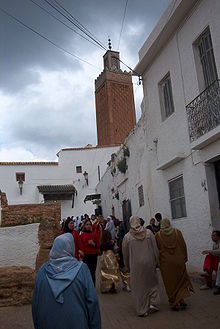Abu Madyan
Sidi Abu Madyan أبو مدين | |
|---|---|
al-Qarawiyyin Béjaïa | |
| Tariqa | Qadiriyya |
| Muslim leader | |
| Disciple of | Sidi Harazem |
Influenced by | |
Influenced
| |


Abu Madyan Shuʿayb ibn al-Husayn al-Ansari al-Andalusi (
Some even refer to him as the national figure of Maghreb mysticism as he was such a forerunner of Sufism in this geographical area. Devoted to the fervent service of God, he helped introduce looking into oneself and harmonizing internal occurrences with the external observances through asceticism.[1]
Among his most famous students were
Life
Abu Madyan was born in
Soon after, Abu Madyan traveled to
Abu Madyan went to Mecca where he met the great Muslim saint,
His beliefs were in opposition to the Almohade doctors of that town. The Almohads were disturbed at his increasing reputation and wanted to get rid of him.
Eventually, Madyan settled in the town of Béjaïa where he established a mosque-school (zawiya). The sheer amount of fame and influence that Abu Madyan evoked raised serious concern from the political powers of the time. The Almohad Caliph
Teachings
The basic principles and virtues taught at Madyan’s school in
According to Yahya B. Khaldun, Abu Madyan's teachings may all be summed up in this verse which he often repeated, "Say Allah! and abandon all that is matter, or is connected with it, if though desirest to attain the truth goal."[6]
Legacy
Aside from attaining Ghawth status and teaching hundreds and hundreds of disciples, Abu Madyan left his mark in more ways than one. He gained immense popularity because he was relatable, despite his high scholarly status. He had a personality and way of speaking that united people from all walks of life, from the common people to the academics. Even to this day, scholars say that no one of the time surpassed him in religious and intellectual influence. His school produced hundreds of saints and out of the 46 Sufi saints in the Rif region, 15 were his disciples. People still visit his tomb today for asking God through him, which is called tawassul, they visit him from all around the world.
Sayings
There are very few surviving writings from Abu Madyan, and of those that do still exist, there are mystical poems, a testament (wasiyya) and a creed (akida). He encouraged the free expression of emotions rather than rigidity, but also made known his support of asceticism complete devotion to God and a minimalist lifestyle.
Works
- Bidayat al Mouridin, Ms 938, Bibliot. Nat. Alger.
- Diwan, (collection of his poems) édit. Chaouar of Tlemcen, Damascus, 1938.
- Ouns al Wahid, Ms 2-105 (8) fol. 337–343, Bibliot. Nat. Paris, ed. in Cairo 1301–1884, with a commentary by Ahmed Bâ'chan.
- Tahfat al Arib, pub. et trad. in Latin par F. de Dombay, Vindobonae, Ebn Médirai Mauri Fessani Sentenciae quaedam arabicae, 1805
- The Way of Abu Madyan, bilingual collection, Islamic Texts Society, Cambridge, 1996. Transl by Vincent Cornell.
- Adab al-Murid, A poem on the etiquette of the murid for beginners on the spiritual path of suluk.
References
- ^ a b "Sidi Boumediene Chouaib, pôle du soufisme au Maghreb: Un nom lié à la ville ancestrale" ["Sidi Boumediene Chouaib, center of Sufism in the Maghreb: A name linked to the ancient city"] Archived 2019-04-14 at the Wayback Machine (in French). El Moudjahid (Algiers). 16 April 2011.
- ISBN 9782745168269 – via Google Books.
- ISBN 9789957791360 – via Google Books.
ومن تلامذة الشيخ أبو مدين شعيب، الشيخ الأكبر محي الدين بن عربي الحاتمي الطائي، وأبو عبد الله حماد الصنهاجي القلعي، والشيخ الفقيه أبو عبد الله محمد بن إبراهيم الأنصاري.
- ^ ISBN 9789004161214.
- ISBN 978-0-19-538207-5.
- ^ The Encyclopaedia of Islam. Leiden: EJ Brill. 1913. pp. 98–99.
- ^ Ibn al-Zayyat al-Tadili (c. 1220). التشوف إلى رجال التصوف (in Arabic) (Ahmed Toufiq ed.). p. 319.
Sources
- Arnaldez, R. "Falsafa". Encyclopaedia of Islam, Second Edition. Edited by: P. Bearman;, Th. Bianquis; C.E. Bosworth;, E. van Donzel; and W.P. Heinrichs. Brill, 2011. Brill Online Augustana. 5 April 2011
- Zarcone, Th.; Hunwick, J.O.; Ernst, C.; Jong, F. de;, L. Massignon-[B. Radtke]; Aubin, Françoise. "Taṣawwuf (a."). Encyclopaedia of Islam, Second Edition. Edited by: P. Bearman;, Th. Bianquis;, C.E. Bosworth;, E. van Donzel; and W.P. Heinrichs. Brill, 2011. Brill Online. Augustana. 5 April 2011
- Griffel, Frank, "Al-Ghazali", The Stanford Encyclopedia of Philosophy (Fall 2008), Edward N. Zalta (ed.),
- Marçais, G. "Abū Madyan, S̲h̲uʿayb b. al-Ḥusayn al-Andalusī". Encyclopaedia of Islam, Second Edition. Edited by: P. Bearman;, Th. Bianquis;, C.E. Bosworth;, E. van Donzel; and W.P. Heinrichs. Brill, 2011. Brill Online. Augustana. 3 April 2011

